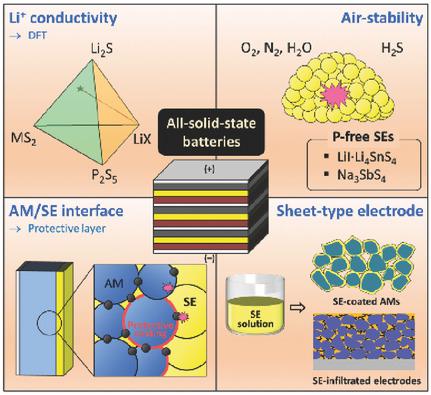当前位置:
X-MOL 学术
›
Adv. Energy Mater.
›
论文详情
Our official English website, www.x-mol.net, welcomes your
feedback! (Note: you will need to create a separate account there.)
Design Strategies, Practical Considerations, and New Solution Processes of Sulfide Solid Electrolytes for All‐Solid‐State Batteries
Advanced Energy Materials ( IF 24.4 ) Pub Date : 2018-04-23 , DOI: 10.1002/aenm.201800035 Kern Ho Park 1 , Qiang Bai 2 , Dong Hyeon Kim 1, 3 , Dae Yang Oh 1, 3 , Yizhou Zhu 2 , Yifei Mo 2 , Yoon Seok Jung 1
Advanced Energy Materials ( IF 24.4 ) Pub Date : 2018-04-23 , DOI: 10.1002/aenm.201800035 Kern Ho Park 1 , Qiang Bai 2 , Dong Hyeon Kim 1, 3 , Dae Yang Oh 1, 3 , Yizhou Zhu 2 , Yifei Mo 2 , Yoon Seok Jung 1
Affiliation

|
Owing to the ever‐increasing safety concerns about conventional lithium‐ion batteries, whose applications have expanded to include electric vehicles and grid‐scale energy storage, batteries with solidified electrolytes that utilize nonflammable inorganic materials are attracting considerable attention. In particular, owing to their superionic conductivities (as high as ≈10−2 S cm−1) and deformability, sulfide materials as the solid electrolytes (SEs) are considered the enabling material for high‐energy bulk‐type all‐solid‐state batteries. Herein the authors provide a brief review on recent progress in sulfide Li‐ and Na‐ion SEs for all‐solid‐state batteries. After the basic principles in designing SEs are considered, the experimental exploration of multicomponent systems and ab initio calculations that accelerate the search for stronger candidates are discussed. Next, other issues and challenges that are critical for practical applications, such as instability in air, electrochemical stability, and compatibility with active materials, are discussed. Then, an emerging progress in liquid‐phase synthesis and solution process of SEs and its relevant prospects in ensuring intimate ionic contacts and fabricating sheet‐type electrodes is highlighted. Finally, an outlook on the future research directions for all‐solid‐state batteries employing sulfide superionic conductors is provided.
中文翻译:

全固态电池硫化物固体电解质的设计策略,实践考虑和新的解决方法
由于对常规锂离子电池安全性的关注与日俱增,常规锂离子电池的应用范围已扩大到电动汽车和电网规模的储能领域,采用不易燃无机材料的具有固态电解质的电池引起了极大的关注。特别是,由于它们的超离子传导性(高达≈10 -2小号厘米-1)和可变形性方面,硫化物材料作为固体电解质(SE)被认为是高能大容量全固态电池的促成材料。本文作者简要回顾了全固态电池硫化锂和钠离子SE的最新进展。在考虑了设计SE的基本原理之后,讨论了多组件系统的实验探索和从头开始的计算,这些计算加快了寻找更强大候选者的速度。接下来,讨论了对于实际应用至关重要的其他问题和挑战,例如空气的不稳定性,电化学稳定性以及与活性材料的相容性。然后,突出了SE的液相合成和固溶过程中的新兴进展,以及在确保紧密的离子接触和制造薄板型电极方面的相关前景。最后,提供了使用硫化物超离子导体的全固态电池未来研究方向的展望。
更新日期:2018-04-23
中文翻译:

全固态电池硫化物固体电解质的设计策略,实践考虑和新的解决方法
由于对常规锂离子电池安全性的关注与日俱增,常规锂离子电池的应用范围已扩大到电动汽车和电网规模的储能领域,采用不易燃无机材料的具有固态电解质的电池引起了极大的关注。特别是,由于它们的超离子传导性(高达≈10 -2小号厘米-1)和可变形性方面,硫化物材料作为固体电解质(SE)被认为是高能大容量全固态电池的促成材料。本文作者简要回顾了全固态电池硫化锂和钠离子SE的最新进展。在考虑了设计SE的基本原理之后,讨论了多组件系统的实验探索和从头开始的计算,这些计算加快了寻找更强大候选者的速度。接下来,讨论了对于实际应用至关重要的其他问题和挑战,例如空气的不稳定性,电化学稳定性以及与活性材料的相容性。然后,突出了SE的液相合成和固溶过程中的新兴进展,以及在确保紧密的离子接触和制造薄板型电极方面的相关前景。最后,提供了使用硫化物超离子导体的全固态电池未来研究方向的展望。































 京公网安备 11010802027423号
京公网安备 11010802027423号